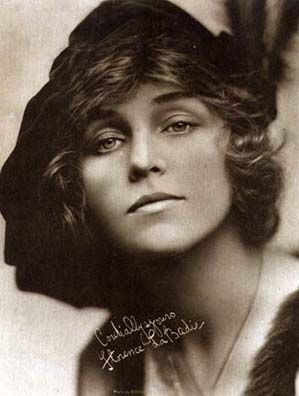
Florence La Badie was an American-Canadian actress in the early days of the silent film era. She was a major star between 1911 and 1917. Her career was at its height when she died at age 29 from injuries sustained in an automobile accident.
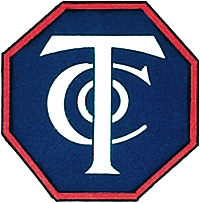
The Thanhouser Company was one of the first motion picture studios, founded in 1909 by Edwin Thanhouser, his wife Gertrude and his brother-in-law Lloyd Lonergan. It operated in New York City until 1920, producing over a thousand films.

Jean, also known as the Vitagraph Dog (1902–1916), was a female collie that starred in silent films. Owned and guided by director Laurence Trimble, she was the first canine to have a leading role in motion pictures. Jean was with Vitagraph Studios from 1909, and in 1913 went with Trimble to England to work with Florence Turner in her own independent film company.

Jack Harvey was an American film actor, director and screenwriter, noted for his short films of the silent period.

A Dog's Love is a 1914 American short silent fantasy drama film with subtitles, directed by Jack Harvey on his directorial debut. It stars Shep the Dog, Helen Badgley, and Arthur Bauer. The film is about a dog who loses his best friend, when a young girl is killed in an automobile accident, and focuses on his emotions in dealing with his loss. Well-received because of its "universally appealing" theme, the dog's emotions were reported as surpassing the child's histrionics.

Shep's Race with Death is a 1914 American short silent drama film, directed by Jack Harvey for the Thanhouser Company. It stars Shep the Dog, Mrs. Whitcove, and J.S. Murray. The film about a "collie dog [who] wins a race with death, saves the life of his mistress, and causes a happy family reunion", was released on November 1, 1914.
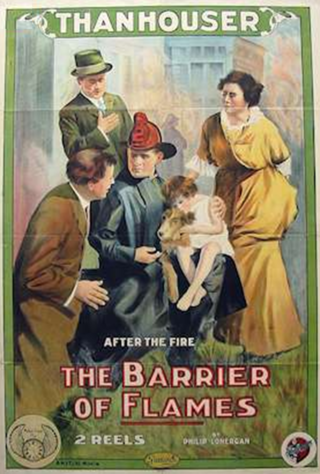
The Barrier of Flames is a 1914 American short silent drama film directed by Jack Harvey. It stars Shep the Dog, Helen Badgley, and Morgan Jones. The film is about a child saved from a fire by her devoted collie.

Morgan Jones was an American silent film actor and writer.

Across the Way is a 1915 American silent short film produced by the Thanhouser Company under the Princess brand. The comedy-drama involves a man named Sparks playing a trick on his friend to make him question his sanity. The trick involves the friend's love interest being attacked by an assailant which works, but then a burglar attacks her a few days later. The friend saves his love interest from the burglar and later marries him instead of Sparks. The Princess comedy-dramas were not well-received and it was not long after the film's release that Edwin Thanhouser took a personal interest in the productions at the New Rochelle studio. Soon thereafter, the Princess brand was discontinued and replaced by the Falstaff brand. The film is presumed to be lost.
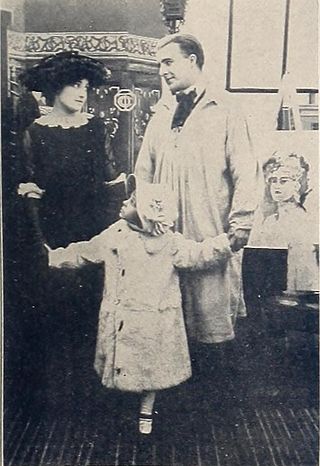
Adrift is a 1911 American silent short drama film produced by the Thanhouser Company and directed by Lucius J. Henderson. The film depicts a story of a young artist whose lack of success leads him to attempt suicide. Before he can carry out the act, his daughter follows and stops him. He confesses to his wife and she thanks her child, providing the inspiration for the artist to complete a great painting. It brings him success and he grows distant from his wife and becomes interested in another woman whom he was commissioned by. Once again saved by his daughter's actions, whose crying moves the woman to break off the relationship with the artist. The artist destroys the painting and learns a moral lesson.

Adrift in a Great City is a 1914 American silent short drama produced by the Thanhouser Film Corporation that stars Florence LaBadie. The film begins with Pat Moran who pays for the passage of his wife and daughter to join him in America, but he is seriously injured on the way to greeting them. Left by themselves, the daughter works in a sweatshop and goes blind, forcing her and her mother to become beggars. By pure happenstance, the blind girl wanders to the hospital where her father is recovering and tells her story to a doctor. The father recognizes the girl as his daughter and the family is reunited, and the doctor confirms her blindness can be cured. The film was reviewed negatively by critics for its poor scenario, settings and technical execution. The film is presumed lost.
The Thanhouser Company was one of the first motion picture studios, founded in 1909 by Edwin Thanhouser. It operated until 1920. It produced over 1,000 films, but several dozen of the films were of small filler subjects, educational or documentaries. Many of these smaller subjects were listed as a quarter or half a reel in length and received very little critical review or analysis by film critics and the media.

Jane Eyre is a 1910 American silent short classic drama produced by the Thanhouser Film Corporation. Adapted from Charlotte Brontë's 1847 novel, Jane Eyre, the film mirrors the events and plot of the original book. The writer of the scenario is unknown, but Lloyd Lonergan probably adapted the work. The film's director is often and erroneously claimed to be Theodore Marston, but Barry O'Neil or Lloyd B. Carleton are possible candidates. The cast of the film was credited, an act rare and unusual in the era.
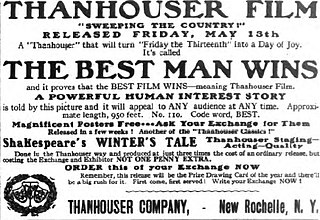
The Best Man Wins is a 1910 American silent short drama produced by the Thanhouser Company. The film features Thanhouser's leading players Anna Rosemond, Martin Faust, Frank H. Crane and Marie Eline in a drama about morality. Two suitors are vying for the hand of Julia Seaton and propose to her on the same day, but she asks for a month to decide between them. In the time, the caliber of both men are tested when asked by a young girl, named May, to help her dying mother. The doctor refuses to help, and the lawyer offers his assistance, but her mother soon dies. The orphan is taken in by the Seaton family and personally attests to the character of both men when Julia Seaton has to choose between her suitors.
Thelma is a 1910 American silent short drama film produced by the Thanhouser Company. The story was based on Marie Corelli's 1887 novel of the same name, it focuses on a Norwegian maiden who meets Sir Phillip and the two are wed. Lady Clara conspires to ruin the marriage and tricks Thelma with a letter purported to be from her husband. Thelma returns to Norway and to the death of her father. Thelma, alone in the world, prays at her mother's grave for strength. Sir Phillip searches for Thelma, ultimately finding her, uncovers the tricks which have been played on them and they fall back in love. Released on June 21, 1910, the film was met with praise in The Moving Picture World. An incomplete print of the film survives in the Library of Congress archives.

Tempest and Sunshine is a 1910 American silent short drama produced by the Thanhouser Company. The film is an adaptation of Mary Jane Holmes's 1854 novel Tempest and Sunshine, and features the devious Tempest and the benevolent Sunshine being wooed by a Dr. Lacey. Tempest and Bill Jeffreys conspire against Sunshine. By intercepting the lovers' letters the doctor instead decides to marry Tempest, but Jeffreys interrupts the ceremony to reveal the conspiracy. The doctor and Sunshine are reunited. The novel was a popular subject of plays and vaudeville, but the Thanhouser adaptation appears to be the first film version for it predates the adaptations in The Complete Index to Literary Sources in Film. Released on June 28, 1910, the production received a favorable review in The Moving Picture News. The film is presumed lost.

The Playwright's Love is a 1910 American silent short drama produced by the Thanhouser Company. The film focuses on a poor playwright named John Russell who is approached by a poor dying woman. Upon her death, John takes guardianship of her daughter named Grace. A decade passes and Grace becomes a young woman as John struggles with his love for her. Then, a suitor approaches Grace and is denied because she loves John. When John learns of this, he proposes to her and is accepted. Released on July 19, 1910, the film received positive reception by film critics. One reviewer noted the similarity to other productions and another reviewer said the film recalled The Prince Chap. The film is presumed lost.

Uncle Tom's Cabin is a 1910 American silent short drama produced by the Thanhouser Company. The film was adapted by from the 1852 novel Uncle Tom's Cabin by Harriet Beecher Stowe. The plot of the Thanhouser production streamlined the actual story to portray the film over the course of a single reel. The film was released on July 26, 1910, on the same day that Vitagraph released the first reel of their own three reel version of Uncle Tom's Cabin. This prompted the Thanhouser Company to advertise against the Vitagraph film by referring to the other as being overly drawn out. The film garnered mixed, but mostly positive reception in trade publications. The film is presumed lost.

Rip Van Winkle is a 1910 American silent short drama produced by the Thanhouser Company. The film is an adaptation of Washington Irving's 1819 short story "Rip Van Winkle" with some differences in the plot. The film focuses on the title character whose idle life is made difficult by his cantankerous wife. Winkle heads into the mountains and encounters spirits of Henry Hudson's men. Upon partaking of their alcohol, Winkle falls into a slumber for twenty years. He returns home and has difficulty proving his identity and must save his property from an unlawful accusation by his rival. After he proves his identity, he is reunited with his family. The title character was played by Frank H. Crane, but the production credits are largely unknown. The film was released on December 6, 1910, and met with positive reviews. The film is presumed lost.

Love and Law is a 1910 American silent short drama produced by the Thanhouser Company. The film begins with a meeting between Tom Egan and Sue Jennings. Sue asks Tom, who had previously been sweethearts, for each others' love letters because she will soon marry another man. On this same night, Jack Deming confronts Tom in a drunken state and brandishing a revolver. Jack seeks vengeance because was put into financial ruin by Tom's speculative advice, but Tom manages to calm him down. Tom pens a letter to Sue and takes his own life, making it appear as if Jack murdered him. Jack is arrested, but a young detective named Violet Gray proves his innocence. Jack and Violet also fall in love. The role of Violet Gray was played by Julia M. Taylor, but the other roles and staff credits are unknown. The film was released on December 13, 1910, it would be the first of four films in the "Violet Gray, Detective" series. The film is presumed lost.





















